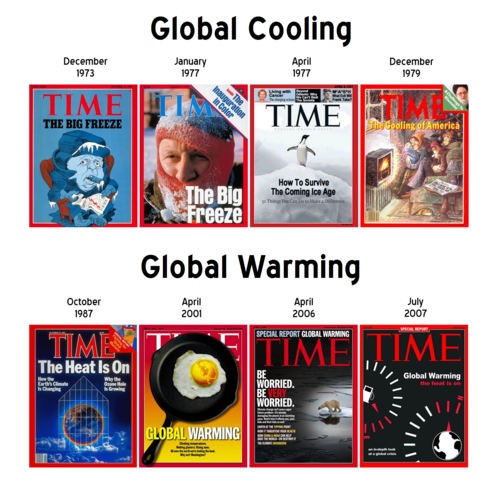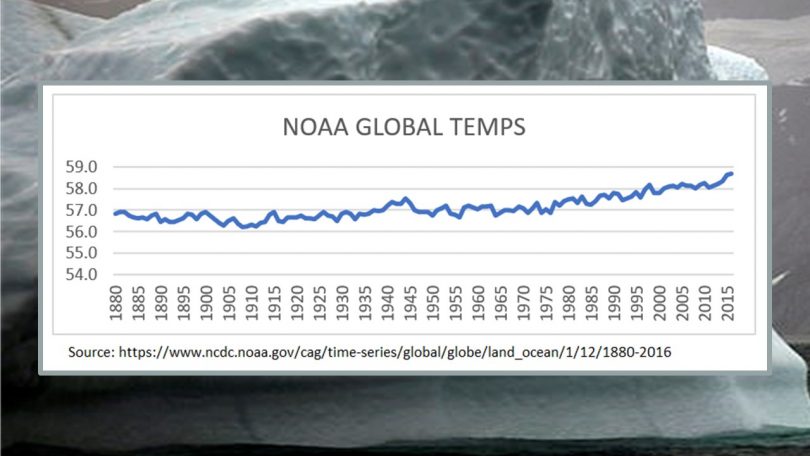
Various unstoppable disaster predictions over the recent decades to consider:
FAMINE. Predicted in 1967, a Los Angeles Times article reported an inevitable worldwide famine that would certainly strike by 1975. Dr. Paul Ehrlich stated at a science symposium at the University of Texas that the “time for famines” was upon us. He claimed this was the case because the world population was out of control. He noted that “the battle to feed humanity will end in a rout.” A Stanford University biologist put the predicament into a bleak reality that “It is already too late for the world to avoid a long period famine.”1 These claims , although made by reputable scientists, proved to be false.

OVERPOPULATION. Dr. Paul Ehrlich predicted that in 1969 the population would find everyone dead before science might provide enough evidence to prove it to be so. Dr. Ehrlich wrote in his best-selling 1968 book “The Population Bomb” that, “In the 1970’s, hundreds of millions of people will starve to death” due to world overpopulation. He summed it up with a grave summation: “We must realize that unless we are extremely lucky, everybody will disappear in a cloud of blue steam in 20 years.” 1 This doomsday prediction, of course, never occurred.

ICE AGE. Also smugly called “global cooling” by many as contrast to modern day’s crisis of global warming was predicted in the early 1970’s by a variety of pop scientific writings and soothsayers. James P. Lodge spoke at the Institute of Environmental Sciences and proclaimed (among many other fear inspiring predictions) that air pollution would soon obscure sunlight and begin the next ice age. Lodge pointed out that this was also partly because we were “already consuming more oxygen then…green plants reproduce.” Lodge envisioned this ice age to be upon us by the start of the 21st century (by the year 2000).1 A Brown University article predicted in 1972 that this ice age would be upon us but they saw it arriving by 2070.1 Lou Dobb’s as a newscaster noted an obvious concern in recent days that that if we went back to the 1970’s we find the fear of global cooling—which today is now a fear of global warming. Even a 1977 Newsweek cover described the impending the ice age while in contrast in 2006 it was predicting global warming. Global cooling or an ice age never emerged in reality.

TOO MUCH GARBAGE- OVERFILLED LANDFILLS. In the 1970’s the federal government began requiring landfills to install lining systems to prevent leaking to outside the landfill as a means of environmental protection. These new expensive requirements caused a new fear to propagate: there was not enough space for all our trash! Of course, this was a false narrative. Today, while the total number of landfills has shrunk from more than 7,600 in the mid-1980’s to roughly 1,900 as of 2013, modern landfills are much more efficient and larger than their predecessors. Also, as per the EPA, due to recycling and other efforts to reduce waste, the amount of trash going into landfills has dropped from 145.3 million tons in 1990 to 134.3 million tons by 2013.1 The fear of overran landfills was a myth.

WATER & FOOD RATIONING. Predicted in 1970 by Dr. Paul Ehrlich (he did a lot of predictions that never happened) believed that our oceans would quickly become “as dead as Lake Erie in less than a decade” and the nation of America would be requiring water rationing by 1974. Ehrlich also saw food rationing would also become required by 1980 in America.1 While the rationale behind these concerns was loosely based in science, none of these predictions came to pass.

OZONE DEPLETION: Predicted in 1974 the ozone would be endangered within a single year by 1975. The reality was it was too late to stop the crisis. The thinning of the ozone layer caused by Freon used in refrigerators and Styrofoam in disposable consumer products had carved the tombstone already. Dr. Donahue of the University of Michigan predicted that the thinned ozone layer would cause the globe climate backwards several hundred million years into the past. “We appear to be on the verge of a period of great peril to life on this globe.” Donahue pointed to a University of Michigan study which revealed that it was too late, even if all emissions were halted immediately, the ozone layer would be destroyed by 1990. Dr. Esch, also from the University of Michigan added while testifying at an environmental subcommittee hearing that “…it may already be too late to prevent serious depletion…and (this) unnerving prediction that the ozone destruction will almost certainly result…no matter what steps we take in the next 12 months.” 1 Important steps were taken to protect the ozone layer and many scientists consider our ozone layer healed or healing. While steps were needed to protect the ozone layer the grave conclusions were proven to be vastly overstated.

ACID RAIN KILLER OF LIFE. First predicted in the early 1980’s acid rain was thought to be killing fish in many lakes including in the US and Canada. Acid rain was destroying lakes at a staggering rate. Deputy minister of Canada’s environmental agency stated, “We’re simply not prepared to contemplate leaving the generations of the next century with tens of thousands or hundreds of thousands of sterile lakes.” The main culprits of this disaster were identified as the coal burning electric plants that were emitting sulfur into the atmosphere. However, within 10 short years from the date of these claims, it was determined that the predictions were largely false. The problems with dying fish were much more complex and involved insecticides and other pollutants. While studies did find a correlation between coal burning electric plants and their sulfur emissions the direct tie toward acid rain as flimsy at best. Here, again, there was cause for concern but the “flat out crisis” as originally decried was overstated.1

GLOBAL WARMING
RISING OCEAN LEVELS TO COVER ISLANDS: Predicted in 1988 by U.N. Environmental officials, “…entire (island) nations could be wiped off the face of the earth by the year 2000…” As an example the Maldives Island nation home to over 200,000 citizens will be completely underwater in the Indian Ocean by this time. Mr. Hussein Shihab of The Environmental Affairs Department stated that the rising ocean levels would be “catastrophic” for most islands which are no more than a meter above sea level. Shihab estimated the oceans to rise 20-30 centimeters over the next few decades. Most scientists believe that, “there is nothing we can do to stop” this from happening. An article in 1988 predicted that New York Cities west side highway would be underwater by 2019.1 Of course, these predictions never manifested.

CHILDREN WILL NEVER SEE SNOW AGAIN. An article in 2000 from The Independent stated that due to global warming, snowfalls would disappear in our lifetimes. That sleds, snowmen, and snowballs were become a mere memory of the past—children would no longer ever experience snow.1 While research can illustrate areas that are having less snowfall within tiny spans of time (such as since 1970), while other areas show increases during this same short time period. It seems the fear of snowfalls being a thing of the past is mere fairy tale.

GLOBAL WARMING TO CAUSE SIBERIAN CLIMATE & DISASTERS. Predicted in 2004 the Pentagon told President Bush that by 2020 global warming would cause worldwide rioting, nuclear war, mega-droughts, and famine. Caused by climate change due to global warming regions of the world including the US and Britain would become sweltering hot similar to the Siberian desert. “Climate change of the next 20 years could result in a global catastrophe costing millions of lives…” 1 Not one of these terrifying predictions occurred.

NO ICE IN THE ARCTIC BY 2018. Predicted in 2008, we will see all the arctic ice gone between 2013-2018. NASA scientist Hansen stated, “…(It’s) occurring right before our eyes…exactly the way we said it would.” These fears were parroted by Al Gore as Presidential candidate who explained by the summer of 2014 – in just 5 years—all the ice caps will be gone. Representative Ed Markey of Massachusetts stated that, “(If) Dr. Hansen was right, we (will) recognize him as a climate prophet.”1 Well, turned out he was not a prophet…the polar caps are still there.

GLOBAL WARMING CAUSES MORE SNOWFALL AND (IRONICALLY) LESS SNOWFALL. Some will take the neutral ground and simply proclaim that the weather has “nothing to do with global warming stupid “.2 While other proponents point to increased snowfalls and snow-packs are due to global warming effects caused by heat pushing more moisture into the atmosphere. They point out that the “atmosphere can hold 4% more moisture for every 10 F increase in temperature”.3 In contrast, other global warming proponents state the opposite, that lower snowfall accumulations are due to higher temperatures which prevent temperatures to be cold enough for snowfalls of the past.4 Both sides are proponents of global warming yet they hold opposing views based on what snowfall data they are reviewing. Ironically, both agree on the cause being global warming but differ on whether there is more or less snowfall. They have inadvertently acknowledged conflicting data depending on when and what regions you are reviewing. This is a problem for all global wide sciences– regions vary greatly. Either way, for the global warming proponents, regardless of how much snow does or does not fall, it is always caused by global warming. Such logic is preposterous.

Those deceptive charts…
Anyone who has taken a course in high school or college in statistics recognizes that the presenter can bias the numbers to present the angle they desire by tailoring the X and Y axis’s. They can also focus on certain time frames where the event was more or less. They can focus on regions that tell the story they are illustrating best. It is in such charts that pop-culture scientists can illustrate the issue of global warming. They illustrate a mere 2.7 degree Fahrenheit variance temperature, over a massive range of 169 years (1850 through 2019) on their charts and make the forecast seem dire. If you look at the charts on the right below it appears that global temperature are headed off the charts. However, it you place the temperature range in a proper context then the charts on the left reveal quite little change. It is always important to recognize that chart axis’s reveals bias.

Perhaps global warming is a reality, perhaps it is not a real issue at all. Either way, if the predictions of the past provide any insight at all, it is that concerns tend to be overstated by both sides of the issue with doomsday extremes. The truth likely falls somewhere in the middle, not strong enough to generate fear but not mild enough to ignore altogether.
Global warming is said to be the mechanism that causes glaciers to shrink, ice to thaw early on rivers and lakes, plants and trees to flower sooner, sea ice melts, and ocean levels rise. There are great examples for each of these effects depending on where and when you look on planet earth.5 In clear contrast, there are also opposite effects of these, depending on where and when you look on earth. There are regions with expanding glaciers, growing sea ice, rivers and lakes not thawing as early as in prior years, plants and trees flowering later due to cooling regional temperatures. There are even areas where ocean levels are lower exposing more land.6 The earth is a dynamically complex place effected by many variables. Affixing single issue problems and solutions, such as global warming, falls short of meeting the demands of good scientific deduction.
1 https://cei.org/blog/wrong-again-50-years-failed-eco-pocalyptic-predictions
3 https://theconversation.com/does-global-warming-mean-more-or-less-snow-36936
4 https://www.scientificamerican.com/article/love-snow-heres-how-its-changing/
5 https://climate.nasa.gov/effects/
6 https://www.nationalgeographic.com/news/2016/09/water-land-sea-levels-shift-map/


